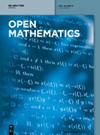求助PDF
{"title":"稳定类星调和映射特殊子类的玻尔不等式","authors":"Wei Jin, Zhihong Liu, Qian Hu, Wenbo Zhang","doi":"10.1515/math-2023-0141","DOIUrl":null,"url":null,"abstract":"The focus of this article is to explore the Bohr inequality for a specific subset of harmonic starlike mappings introduced by Ghosh and Vasudevarao (<jats:italic>Some basic properties of certain subclass of harmonic univalent functions</jats:italic>, Complex Var. Elliptic Equ. 63 (2018), no. 12, 1687–1703.). This set is denoted as <jats:inline-formula> <jats:alternatives> <jats:inline-graphic xmlns:xlink=\"http://www.w3.org/1999/xlink\" xlink:href=\"graphic/j_math-2023-0141_eq_001.png\" /> <m:math xmlns:m=\"http://www.w3.org/1998/Math/MathML\"> <m:msubsup> <m:mrow> <m:mi mathvariant=\"script\">ℬ</m:mi> </m:mrow> <m:mrow> <m:mi>H</m:mi> </m:mrow> <m:mrow> <m:mn>0</m:mn> </m:mrow> </m:msubsup> <m:mrow> <m:mo>(</m:mo> <m:mrow> <m:mi>M</m:mi> </m:mrow> <m:mo>)</m:mo> </m:mrow> <m:mo>≔</m:mo> <m:mrow> <m:mo stretchy=\"false\">{</m:mo> <m:mrow> <m:mi>f</m:mi> <m:mo>=</m:mo> <m:mi>h</m:mi> <m:mo>+</m:mo> <m:mover accent=\"true\"> <m:mrow> <m:mi>g</m:mi> </m:mrow> <m:mrow> <m:mo stretchy=\"true\">¯</m:mo> </m:mrow> </m:mover> <m:mo>∈</m:mo> <m:msub> <m:mrow> <m:mi mathvariant=\"script\">ℋ</m:mi> </m:mrow> <m:mrow> <m:mn>0</m:mn> </m:mrow> </m:msub> <m:mo>:</m:mo> <m:mrow> <m:mo stretchy=\"false\">∣</m:mo> <m:mrow> <m:mi>z</m:mi> <m:msup> <m:mrow> <m:mi>h</m:mi> </m:mrow> <m:mrow> <m:mo accent=\"true\">″</m:mo> </m:mrow> </m:msup> <m:mrow> <m:mo>(</m:mo> <m:mrow> <m:mi>z</m:mi> </m:mrow> <m:mo>)</m:mo> </m:mrow> </m:mrow> <m:mo stretchy=\"false\">∣</m:mo> </m:mrow> <m:mo>≤</m:mo> <m:mi>M</m:mi> <m:mo>−</m:mo> <m:mrow> <m:mo stretchy=\"false\">∣</m:mo> <m:mrow> <m:mi>z</m:mi> <m:msup> <m:mrow> <m:mi>g</m:mi> </m:mrow> <m:mrow> <m:mo accent=\"true\">″</m:mo> </m:mrow> </m:msup> <m:mrow> <m:mo>(</m:mo> <m:mrow> <m:mi>z</m:mi> </m:mrow> <m:mo>)</m:mo> </m:mrow> </m:mrow> <m:mo stretchy=\"false\">∣</m:mo> </m:mrow> </m:mrow> <m:mo stretchy=\"false\">}</m:mo> </m:mrow> </m:math> <jats:tex-math>{{\\mathcal{ {\\mathcal B} }}}_{H}^{0}\\left(M):= \\{f=h+\\overline{g}\\in {{\\mathcal{ {\\mathcal H} }}}_{0}:| z{h}^{^{\\prime\\prime} }\\left(z)| \\le M-| z{g}^{^{\\prime\\prime} }\\left(z)| \\}</jats:tex-math> </jats:alternatives> </jats:inline-formula> for <jats:inline-formula> <jats:alternatives> <jats:inline-graphic xmlns:xlink=\"http://www.w3.org/1999/xlink\" xlink:href=\"graphic/j_math-2023-0141_eq_002.png\" /> <m:math xmlns:m=\"http://www.w3.org/1998/Math/MathML\"> <m:mi>z</m:mi> <m:mo>∈</m:mo> <m:mi mathvariant=\"double-struck\">D</m:mi> </m:math> <jats:tex-math>z\\in {\\mathbb{D}}</jats:tex-math> </jats:alternatives> </jats:inline-formula>, where <jats:inline-formula> <jats:alternatives> <jats:inline-graphic xmlns:xlink=\"http://www.w3.org/1999/xlink\" xlink:href=\"graphic/j_math-2023-0141_eq_003.png\" /> <m:math xmlns:m=\"http://www.w3.org/1998/Math/MathML\"> <m:mn>0</m:mn> <m:mo><</m:mo> <m:mi>M</m:mi> <m:mo>≤</m:mo> <m:mn>1</m:mn> </m:math> <jats:tex-math>0\\lt M\\le 1</jats:tex-math> </jats:alternatives> </jats:inline-formula>. It is worth mentioning that the functions belonging to the class <jats:inline-formula> <jats:alternatives> <jats:inline-graphic xmlns:xlink=\"http://www.w3.org/1999/xlink\" xlink:href=\"graphic/j_math-2023-0141_eq_004.png\" /> <m:math xmlns:m=\"http://www.w3.org/1998/Math/MathML\"> <m:msubsup> <m:mrow> <m:mi mathvariant=\"script\">ℬ</m:mi> </m:mrow> <m:mrow> <m:mi>H</m:mi> </m:mrow> <m:mrow> <m:mn>0</m:mn> </m:mrow> </m:msubsup> <m:mrow> <m:mo>(</m:mo> <m:mrow> <m:mi>M</m:mi> </m:mrow> <m:mo>)</m:mo> </m:mrow> </m:math> <jats:tex-math>{{\\mathcal{ {\\mathcal B} }}}_{H}^{0}\\left(M)</jats:tex-math> </jats:alternatives> </jats:inline-formula> are recognized for their stability as starlike harmonic mappings. With this in mind, this research has a twofold goal: first, to determine the optimal Bohr radius for this specific subclass of harmonic mappings, and second, to extend the Bohr-Rogosinski phenomenon to the same subclass.","PeriodicalId":48713,"journal":{"name":"Open Mathematics","volume":"731 1","pages":""},"PeriodicalIF":0.9000,"publicationDate":"2023-12-01","publicationTypes":"Journal Article","fieldsOfStudy":null,"isOpenAccess":false,"openAccessPdf":"","citationCount":"0","resultStr":"{\"title\":\"On Bohr's inequality for special subclasses of stable starlike harmonic mappings\",\"authors\":\"Wei Jin, Zhihong Liu, Qian Hu, Wenbo Zhang\",\"doi\":\"10.1515/math-2023-0141\",\"DOIUrl\":null,\"url\":null,\"abstract\":\"The focus of this article is to explore the Bohr inequality for a specific subset of harmonic starlike mappings introduced by Ghosh and Vasudevarao (<jats:italic>Some basic properties of certain subclass of harmonic univalent functions</jats:italic>, Complex Var. Elliptic Equ. 63 (2018), no. 12, 1687–1703.). This set is denoted as <jats:inline-formula> <jats:alternatives> <jats:inline-graphic xmlns:xlink=\\\"http://www.w3.org/1999/xlink\\\" xlink:href=\\\"graphic/j_math-2023-0141_eq_001.png\\\" /> <m:math xmlns:m=\\\"http://www.w3.org/1998/Math/MathML\\\"> <m:msubsup> <m:mrow> <m:mi mathvariant=\\\"script\\\">ℬ</m:mi> </m:mrow> <m:mrow> <m:mi>H</m:mi> </m:mrow> <m:mrow> <m:mn>0</m:mn> </m:mrow> </m:msubsup> <m:mrow> <m:mo>(</m:mo> <m:mrow> <m:mi>M</m:mi> </m:mrow> <m:mo>)</m:mo> </m:mrow> <m:mo>≔</m:mo> <m:mrow> <m:mo stretchy=\\\"false\\\">{</m:mo> <m:mrow> <m:mi>f</m:mi> <m:mo>=</m:mo> <m:mi>h</m:mi> <m:mo>+</m:mo> <m:mover accent=\\\"true\\\"> <m:mrow> <m:mi>g</m:mi> </m:mrow> <m:mrow> <m:mo stretchy=\\\"true\\\">¯</m:mo> </m:mrow> </m:mover> <m:mo>∈</m:mo> <m:msub> <m:mrow> <m:mi mathvariant=\\\"script\\\">ℋ</m:mi> </m:mrow> <m:mrow> <m:mn>0</m:mn> </m:mrow> </m:msub> <m:mo>:</m:mo> <m:mrow> <m:mo stretchy=\\\"false\\\">∣</m:mo> <m:mrow> <m:mi>z</m:mi> <m:msup> <m:mrow> <m:mi>h</m:mi> </m:mrow> <m:mrow> <m:mo accent=\\\"true\\\">″</m:mo> </m:mrow> </m:msup> <m:mrow> <m:mo>(</m:mo> <m:mrow> <m:mi>z</m:mi> </m:mrow> <m:mo>)</m:mo> </m:mrow> </m:mrow> <m:mo stretchy=\\\"false\\\">∣</m:mo> </m:mrow> <m:mo>≤</m:mo> <m:mi>M</m:mi> <m:mo>−</m:mo> <m:mrow> <m:mo stretchy=\\\"false\\\">∣</m:mo> <m:mrow> <m:mi>z</m:mi> <m:msup> <m:mrow> <m:mi>g</m:mi> </m:mrow> <m:mrow> <m:mo accent=\\\"true\\\">″</m:mo> </m:mrow> </m:msup> <m:mrow> <m:mo>(</m:mo> <m:mrow> <m:mi>z</m:mi> </m:mrow> <m:mo>)</m:mo> </m:mrow> </m:mrow> <m:mo stretchy=\\\"false\\\">∣</m:mo> </m:mrow> </m:mrow> <m:mo stretchy=\\\"false\\\">}</m:mo> </m:mrow> </m:math> <jats:tex-math>{{\\\\mathcal{ {\\\\mathcal B} }}}_{H}^{0}\\\\left(M):= \\\\{f=h+\\\\overline{g}\\\\in {{\\\\mathcal{ {\\\\mathcal H} }}}_{0}:| z{h}^{^{\\\\prime\\\\prime} }\\\\left(z)| \\\\le M-| z{g}^{^{\\\\prime\\\\prime} }\\\\left(z)| \\\\}</jats:tex-math> </jats:alternatives> </jats:inline-formula> for <jats:inline-formula> <jats:alternatives> <jats:inline-graphic xmlns:xlink=\\\"http://www.w3.org/1999/xlink\\\" xlink:href=\\\"graphic/j_math-2023-0141_eq_002.png\\\" /> <m:math xmlns:m=\\\"http://www.w3.org/1998/Math/MathML\\\"> <m:mi>z</m:mi> <m:mo>∈</m:mo> <m:mi mathvariant=\\\"double-struck\\\">D</m:mi> </m:math> <jats:tex-math>z\\\\in {\\\\mathbb{D}}</jats:tex-math> </jats:alternatives> </jats:inline-formula>, where <jats:inline-formula> <jats:alternatives> <jats:inline-graphic xmlns:xlink=\\\"http://www.w3.org/1999/xlink\\\" xlink:href=\\\"graphic/j_math-2023-0141_eq_003.png\\\" /> <m:math xmlns:m=\\\"http://www.w3.org/1998/Math/MathML\\\"> <m:mn>0</m:mn> <m:mo><</m:mo> <m:mi>M</m:mi> <m:mo>≤</m:mo> <m:mn>1</m:mn> </m:math> <jats:tex-math>0\\\\lt M\\\\le 1</jats:tex-math> </jats:alternatives> </jats:inline-formula>. It is worth mentioning that the functions belonging to the class <jats:inline-formula> <jats:alternatives> <jats:inline-graphic xmlns:xlink=\\\"http://www.w3.org/1999/xlink\\\" xlink:href=\\\"graphic/j_math-2023-0141_eq_004.png\\\" /> <m:math xmlns:m=\\\"http://www.w3.org/1998/Math/MathML\\\"> <m:msubsup> <m:mrow> <m:mi mathvariant=\\\"script\\\">ℬ</m:mi> </m:mrow> <m:mrow> <m:mi>H</m:mi> </m:mrow> <m:mrow> <m:mn>0</m:mn> </m:mrow> </m:msubsup> <m:mrow> <m:mo>(</m:mo> <m:mrow> <m:mi>M</m:mi> </m:mrow> <m:mo>)</m:mo> </m:mrow> </m:math> <jats:tex-math>{{\\\\mathcal{ {\\\\mathcal B} }}}_{H}^{0}\\\\left(M)</jats:tex-math> </jats:alternatives> </jats:inline-formula> are recognized for their stability as starlike harmonic mappings. With this in mind, this research has a twofold goal: first, to determine the optimal Bohr radius for this specific subclass of harmonic mappings, and second, to extend the Bohr-Rogosinski phenomenon to the same subclass.\",\"PeriodicalId\":48713,\"journal\":{\"name\":\"Open Mathematics\",\"volume\":\"731 1\",\"pages\":\"\"},\"PeriodicalIF\":0.9000,\"publicationDate\":\"2023-12-01\",\"publicationTypes\":\"Journal Article\",\"fieldsOfStudy\":null,\"isOpenAccess\":false,\"openAccessPdf\":\"\",\"citationCount\":\"0\",\"resultStr\":null,\"platform\":\"Semanticscholar\",\"paperid\":null,\"PeriodicalName\":\"Open Mathematics\",\"FirstCategoryId\":\"100\",\"ListUrlMain\":\"https://doi.org/10.1515/math-2023-0141\",\"RegionNum\":4,\"RegionCategory\":\"数学\",\"ArticlePicture\":[],\"TitleCN\":null,\"AbstractTextCN\":null,\"PMCID\":null,\"EPubDate\":\"\",\"PubModel\":\"\",\"JCR\":\"Q1\",\"JCRName\":\"MATHEMATICS\",\"Score\":null,\"Total\":0}","platform":"Semanticscholar","paperid":null,"PeriodicalName":"Open Mathematics","FirstCategoryId":"100","ListUrlMain":"https://doi.org/10.1515/math-2023-0141","RegionNum":4,"RegionCategory":"数学","ArticlePicture":[],"TitleCN":null,"AbstractTextCN":null,"PMCID":null,"EPubDate":"","PubModel":"","JCR":"Q1","JCRName":"MATHEMATICS","Score":null,"Total":0}
引用次数: 0
引用
批量引用
On Bohr's inequality for special subclasses of stable starlike harmonic mappings
The focus of this article is to explore the Bohr inequality for a specific subset of harmonic starlike mappings introduced by Ghosh and Vasudevarao (Some basic properties of certain subclass of harmonic univalent functions , Complex Var. Elliptic Equ. 63 (2018), no. 12, 1687–1703.). This set is denoted as ℬ H 0 ( M ) ≔ { f = h + g ¯ ∈ ℋ 0 : ∣ z h ″ ( z ) ∣ ≤ M − ∣ z g ″ ( z ) ∣ } {{\mathcal{ {\mathcal B} }}}_{H}^{0}\left(M):= \{f=h+\overline{g}\in {{\mathcal{ {\mathcal H} }}}_{0}:| z{h}^{^{\prime\prime} }\left(z)| \le M-| z{g}^{^{\prime\prime} }\left(z)| \} for z ∈ D z\in {\mathbb{D}} , where 0 < M ≤ 1 0\lt M\le 1 . It is worth mentioning that the functions belonging to the class ℬ H 0 ( M ) {{\mathcal{ {\mathcal B} }}}_{H}^{0}\left(M) are recognized for their stability as starlike harmonic mappings. With this in mind, this research has a twofold goal: first, to determine the optimal Bohr radius for this specific subclass of harmonic mappings, and second, to extend the Bohr-Rogosinski phenomenon to the same subclass.

 求助内容:
求助内容: 应助结果提醒方式:
应助结果提醒方式:


